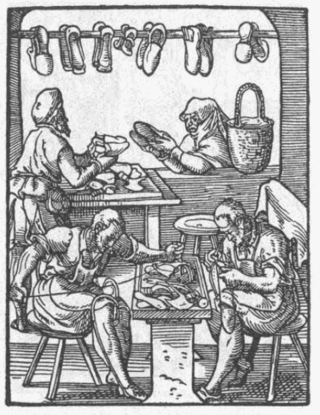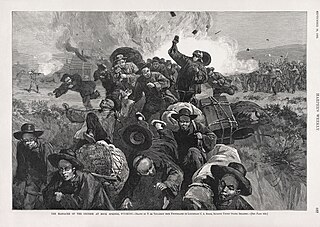
The Knights of Labor, officially the Noble and Holy Order of the Knights of Labor, was an American labor federation that was active in the late 19th century, especially the 1880s. It operated in the United States as well in Canada, and had chapters also in Great Britain and Australia. Its most important leader was Terence V. Powderly. The Knights of Labor promoted the social and cultural uplift of the worker, and demanded the eight-hour day. In some cases it acted as a labor union, negotiating with employers, but it was never well organized or funded. It was notable in its ambition to organize across lines of gender and race and in the inclusion of both skilled and unskilled labor. After a rapid expansion in the mid-1880s, it suddenly lost its new members and became a small operation again. The Knights of Labor had served, however, as the first mass organization of the white working class of the United States.

The Chinese Exclusion Act was a United States federal law signed by President Chester A. Arthur on May 6, 1882, prohibiting all immigration of Chinese laborers for 10 years. The law made exceptions for merchants, teachers, students, travelers, and diplomats. The Chinese Exclusion Act was the first major U.S. law ever implemented to prevent all members of a specific national group from immigrating to the United States, and therefore helped shape twentieth-century race-based immigration policy.

In United States history, the Gilded Age is described as the period from about the 1870s to the late 1890s, which occurred between the Reconstruction Era and the Progressive Era. It was named after an 1873 Mark Twain novel by historians in the 1920s who saw this interval of economic expansion as an era of materialistic excesses combined with political corruption.

Shoemaking is the process of making footwear.
The Asiatic Exclusion League was an organization formed in the early 20th century in the United States and Canada that aimed to prevent immigration of people of Asian origin.

The Immigration Act of 1917 was a United States Act that aimed to restrict immigration by imposing literacy tests on immigrants, creating new categories of inadmissible persons, and barring immigration from the Asia-Pacific zone. The most sweeping immigration act the United States had passed until that time, it followed the Chinese Exclusion Act of 1882 in marking a turn toward nativism. The 1917 act governed immigration policy until it was amended by the Immigration Act of 1924; both acts were revised by the Immigration and Nationality Act of 1952.
Asian immigration to the United States refers to immigration to the United States from part of the continent of Asia, which includes East Asia, South Asia, and Southeast Asia. Asian-origin populations have historically been in the territory that would eventually become the United States since the 16th century. The first major wave of Asian immigration occurred in the late 19th century, primarily in Hawaii and the West Coast. Asian Americans experienced exclusion, and limitations to immigration, by the United States law between 1875 and 1965, and were largely prohibited from naturalization until the 1940s. Since the elimination of Asian exclusion laws and the reform of the immigration system in the Immigration and Nationality Act of 1965, there has been a large increase in the number of immigrants to the United States from Asia.
Chain migration is the social process by which immigrants from a particular area follow others from that area to a particular destination. The destination may be in another country or in a new location within the same country.

The history of Chinese Americans or the history of ethnic Chinese in the United States includes three major waves of Chinese immigration to the United States, beginning in the 19th century. Chinese immigrants in the 19th century worked in the California Gold Rush of the 1850s and the Central Pacific Railroad in the 1860s. They also worked as laborers in Western mines. They suffered racial discrimination at every level of White society. Many Americans were stirred to anger by the "Yellow Peril" rhetoric. Despite provisions for equal treatment of Chinese immigrants in the 1868 Burlingame Treaty between the U.S. and China, political and labor organizations rallied against "cheap Chinese labor".
The Order of the Knights of St. Crispin was an American labor union of shoe workers formed in Wisconsin in 1867. It soon reached a membership of 50,000 or more, largely in the Northeast. However it was poorly organized and faded away by 1874. They fought to prevent innovation, including the introduction of new machinery, and worked to keep immigrant labor out of the workforce.
On February 19, 1862, the 37th United States Congress passed An Act to Prohibit the "Coolie Trade" by American Citizens in American Vessels. The act, which would be called the Anti-Coolie Act of 1862 in short, was passed by the California State Legislature in an attempt to appease rising anger among white laborers about salary competition created by the influx of Chinese immigrants at the height of the California Gold Rush. The act sought to protect white laborers by imposing a monthly tax on Chinese immigrants seeking to do business in the state of California.

The Rock Springs massacre, also known as the Rock Springs riot, occurred on September 2, 1885, in the present-day United States city of Rock Springs in Sweetwater County, Wyoming. The riot, and resulting massacre of immigrant Chinese miners by European immigrant miners, was the result of racial prejudice toward the Chinese miners, who were perceived to be taking jobs from the existing miners. The Union Pacific Coal Department found it economically beneficial to give preference in hiring to Chinese miners, who were willing to work for lower wages than their European counterparts, which angered the existing miners. When the rioting ended, at least 28 Chinese miners were dead and 15 were injured. Rioters burned 78 Chinese homes, resulting in approximately $150,000 in property damage. Despite the identification of the perpetrators, no individuals were prosecuted for the murders or property destruction.

A Different Mirror: A History of Multicultural America is a book by Ronald Takaki. It received an Anisfield-Wolf Book Award and an American Book Award in 1994.

The padrone system was a contract labor system utilized by many immigrant groups to find employment in the United States, most notably Italian, but also Greeks, Chinese, Japanese, and Mexican Americans. The word 'padrone' is an Italian word meaning 'boss', 'manager' or 'owner' when translated into English. The system was a complex network of business relationships formed to meet a growing need for skilled and unskilled workers. Padrones were labor brokers, usually immigrants or first-generation Americans themselves, who acted as middlemen between immigrant workers and employers.
The Daughters of St. Crispin was an American labor union of female shoemakers, founded in Lynn, Massachusetts on July 28, 1869, and was the first national women's labor union in the United States.
The Cantaloupe strike of 1928 was labor movement of cantaloupe pickers in Imperial Valley, California. On May 7, 1928 cantaloupe pickers walked off of the job and the strike lasted to May 10 of the same year. The strikers had hardly any outside support and many were effectively imprisoned by local police for gathering together in any public space during the strike. The strikers were mostly Mexican immigrants or of Mexican descent because they comprised the vast majority of produce laborers in California, about 3,500 to 4,000 Mexicans worked as cantaloupe pickers. While the strike was short-lived and seemingly unorganized, it stands as a victory for the workers.
Chinese Americans in the Pacific Northwest have been around since as early as the 1850s. Chinese Americans arrived in the Greater Seattle area in as early as 1851. Oregon had also seen an influx of Chinese Immigrants as early as 1851, because of mining opportunities. Idaho saw an influx of Chinese Immigrants in the late-19th century, and by 1870 saw a population of around 4,000 Chinese immigrants. The influx of Chinese immigrants in the Pacific Northwest and the rest of the Western United States led to retaliation by whites, leading to anti-Chinese sentiment in the United States. These sentiment then led to the Chinese Exclusion Act of 1882, which expelled many Chinese Americans in the Pacific Northwest. Chinese exclusion is also driven by the failure of restriction. The United States had passed the Chinese Exclusion Act of 1882 to slow immigration, and mend Sinophobia in the west. However, the enforcement of the exclusion act was lackluster. The United States Department of Treasury had found itself with no money to enforce this law. Thus, nullifying the purpose of the exclusion act. Additionally, under the Chinese Exclusion Act of 1882, Chinese people could migrate to the United States if they were return immigrants. Consequently, Chinese immigrants began claiming that they were return immigrants so that they could work in the United States. This also made the Chinese Exclusion Act 1882 useless. This led the United States government to pass the Scott Act of 1888. This excluded all Chinese immigration because it was cheaper, and it appeased the racial tensions in the west.

Asian American activism broadly refers to the political movements and social justice activities involving Asian Americans. Since the first wave of Asian immigration to the United States, Asians have been actively engaged in social and political organizing. The early Asian American activism was mainly organized in response to the anti-Asian racism and Asian exclusion laws in the late-nineteenth century, but during this period, there was no sense of collective Asian American identity. Different ethnic groups organized in their own ways to address the discrimination and exclusion laws separately. It was not until the 1960s when the collective identity was developed from the civil rights movements and different Asian ethnic groups started to come together to fight against anti-Asian racism as a whole.

The George Dee Magic Washing Machine Company commissioned Uncle Sam Kicks Out The Chinaman in 1886. Published in Chicago by Shober & Carqueville Lithograph Co. the cartoon depicts patriotic symbol Uncle Sam kicking out the Chinese in order to promote The George Dee Magic Washing Machine Company's new detergent in an effort to displace Chinese laundry operators. Above the borders of the image an advertisement in the lithograph reads:
To Whom It May Concern: This is a Liquid Washing Compound, and is FULLY GUARANTEED BETTER THAN ANYTHING EVER OFFERED TO THE PUBLIC; its constant use will not injure the cloths nor turn them yellow. For sale by the Gallon, Half-Gallon and Quart. TRY A SAMPLE AND BE SURPRISED.











